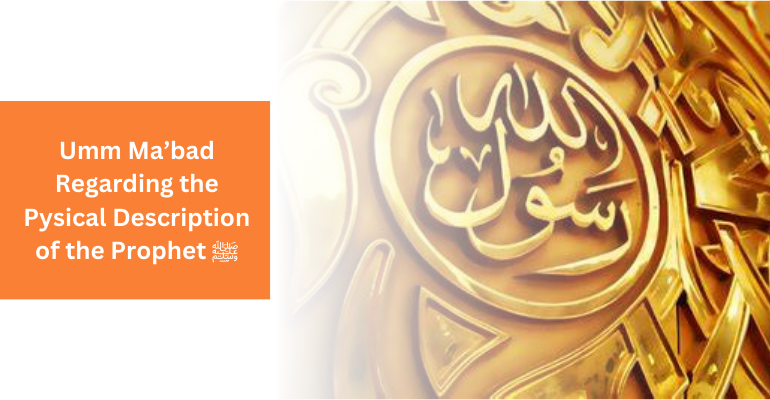In the name of Allāh, ar-Raḥmān (the most merciful), ar-Raḥīm (the bestower of mercy).
During the hijrah, the Prophet ﷺ passed by an elderly non-Muslim woman called Umm Ma’bad al-Khuzā’iyyah. He stopped at her place to seek provisions and rest. Her husband was away tending to his flock whilst the Prophet ﷺ visited. When he returned, she described the physical features and appearance of the Prophet ﷺ in great detail:
“I saw a man whose beauty was clear. His forehead was luminous and shining. He was of handsome disposition.
He was well-defined without having a protruding stomach; he was not small-headed, rather he was handsome and all his features were well-proportioned.
His eyes were wide with strikingly black pupils; his eyelashes were long; his voice was clear and raspy (i.e. husky and manly).
His neck was slender and long; his beard was dense and curly; He had wide eyes which were bright white and [the pupils] intense black. His eyebrows were thin and naturally arched, and his two eyebrows [almost] met.
His hair was dark black. When he was silent he would be enveloped in an aura of nobility. When he spoke, he would raise his head.
Majestic in his beauty; the most handsome of people; dazzling from afar, and the best and pleasant of them from near.
Sweet and clear in his speech; he never gave short sharp answers, and neither was he long-winded when he spoke. His speech would flow like beads falling off a necklace.
He was of average height; an eye would not look past him due to his shortness nor and be overpowered by his height.
He was like a branch between two others; he was the most radiant of the three and best in status.
His companions would surround him. When he spoke, they listened attentively, and when he commanded, they would rush to fulfill his command.
He was well-served [by his companions]; sociable, amicable, and well-liked; He would not frown [rather he was cheerful disposition]; nor disparaging and belittling of others.” [1]
Footnotes
[1] Her words have been narrated in various books of ḥadīth and sīrah including: at-Tabarāni in “al-Mu’jam al-Kabīr”; al-Ḥākim in “al-Mustadrak”; Ibn Kathīr in “al-Bidāyah wan-Nihāyah”; Ibn Hishām in his “Sīrah”; Ibn al-Qayyim in “Zād al-Ma’ād”; and al-Mubārakphuri in “ar-Rahīq al-Makhtūm”.
قالت أم معبد الخزاعية عن رسول الله ﷺ وهي تصفه لزوجها:
“رأيتُ رَجُلًا ظَاهِرَ الْوَضَاءَةِ أَبْلَجَ الْوَجْهِ حَسَنَ الْـخَلُقِ.
لَمْ تَعِبْهُ ثُجْلَةٌ وَلَمْ تُزْرِ بِهِ صعْلَةٌ وَسِيمًا قَسِيمًا.
فِي عَيْنَيْهِ دَعَجٌ وَفِي أَشْفَارِهِ وَطَفٌ وَفِي صوَتِهِ صَحَلٌ.
وَفِي عُنُقِهِ سَطَعٌ. وَفِي لِحْيَتِهِ كَثَاثَةٌ أَحْوَرُ أَكْحَلُ أَزَجُّ أَقْرَنُ.
شَدِيدُ سَوَادِ الشّعْرِ إذَا صَمَتَ عَلاهُ الْوَقَارُ وَإِذَا تَكَلّمَ سَما.
عَلاهُ الْبَهَاءُ أَجْمَلُ النّاسِ وَأَبْهَاهُ مِنْ بَعِيدٍ وَأَحْسَنُهُم وَأَحْلاهُم مِنْ قَرِيبٍ.
حُلْوُ الْمَنْطِقِ فصل لا نَزْرٌ ولا هَذَرٌ كَأَنّ مَنْطِقَهُ خَرَزَاتُ نَظْمٍ يَنحدرنَ.
رَبْعَةٌ لا تَقْتَحِمُهُ عَيْنٌ مِنْ قِصَرٍ ولا تَشْنَؤُهُ مِنْ طُولٍ.
غُصْنٌ بَيْنَ غُصْنَيْنِ فَهُوَ أَنْضَرُ الثلاثَةِ مَنْظَرًا، وَأَحْسَنُهُمْ قَدًا.
لَهُ رُفَقَاءُ يَحُفّونَ بِهِ ، إن قَالَ اسْتَمَعُوا لِقَوْلِهِ. وَإن أَمَرَ تَبَادَرُوا إلَى أَمْرِهِ.
مَحْفُودٌ مَحْشُودٌ لا عَابِسٍ وَلا مُفْنِدٌ.”

